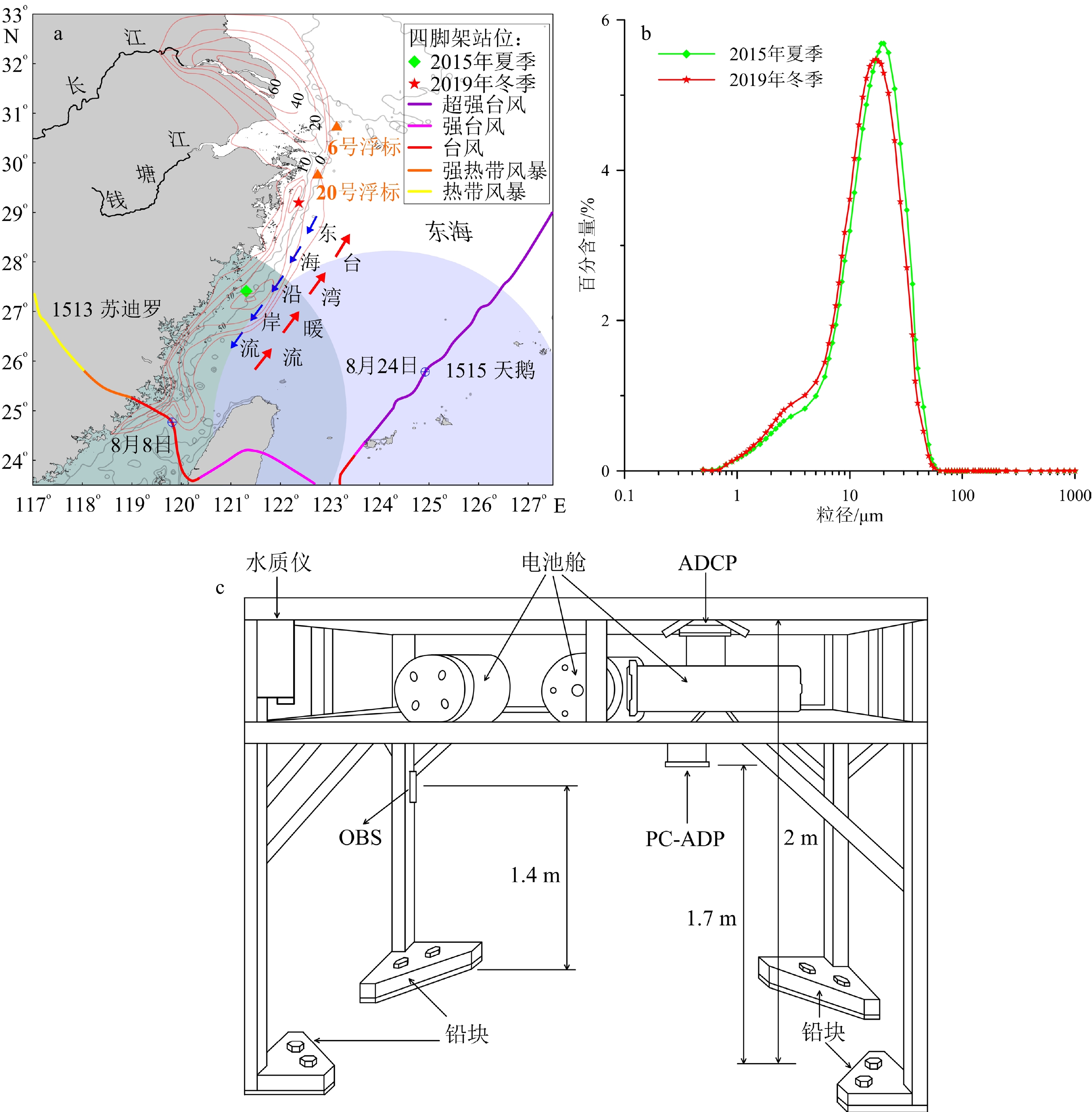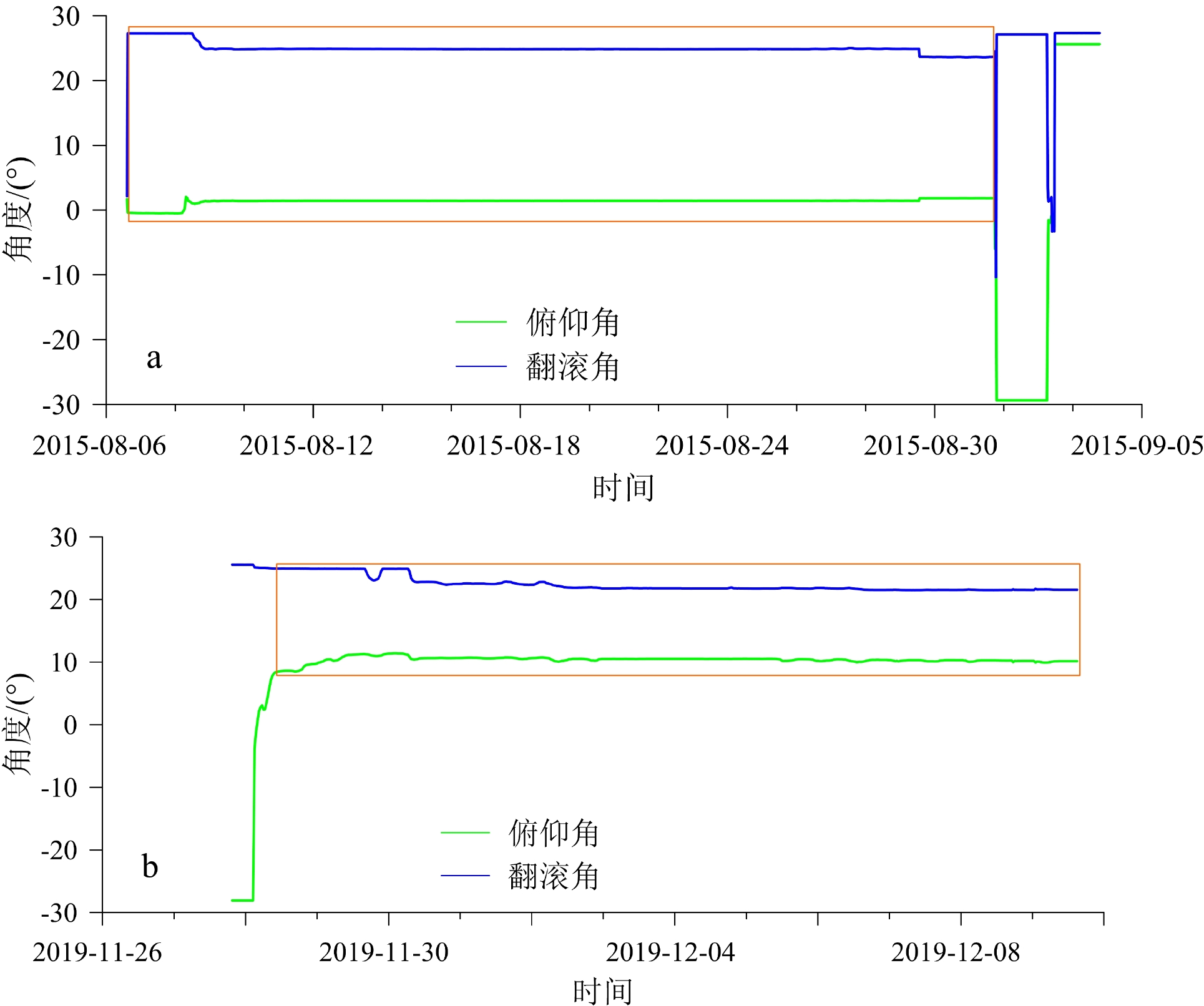Differences in sedimentary dynamic processes between summer typhoons and winter cold waves on the inner shelf of the East China Sea: Insights from in-situ observations
-
摘要: 在全球变暖的背景下,台风活动在未来如何发展是关系到人类社会安全的重大问题之一。受器测记录时间长度的限制,我们对于台风长期的发展与演化机制的认识还不充分。从东海内陆架泥质区的沉积记录中提取台风信息,是了解几千年来影响我国的台风演变规律的有效手段。但是,其他极端事件,尤其是冬季寒潮,会影响台风沉积事件识别的准确性。台风与冬季寒潮大风沉积事件的辨识也是台风活动重建的难点之一。利用布放在东海内陆架泥质区的四脚架观测系统,分别获取了台风“天鹅”和冬季寒潮大风期间的海水温度、盐度、悬浮体浓度和海流等数据,并结合近海观测浮标的风速、风向和波浪等数据,探讨了台风与冬季寒潮沉积动力过程的差异。结果表明,台风与冬季寒潮在风向、有效波高和近底层流速变化上有一定的相似性,但是台风较高的强度更容易引起近底层沉积物的再悬浮;台风经过时,高浓度悬浮体主要来自海底沉积物的再悬浮,而冬季寒潮期间高浓度悬浮体与长江入海物质的输入有关。由于台风和冬季寒潮近底层海流流向的差异,在东海内陆架泥质区向海一侧边缘沉积记录中的砂层可能代表了台风事件沉积,是研究台风活动规律的良好研究材料。研究结果为从东海泥质区沉积记录中提取更准确的台风信息提供了科学参考。Abstract: One of the major challenges addressing human life safety in the context of global warming is how typhoon activity may develop in the future. Our understanding of typhoon long-term development and evolution mechanisms is limited by the duration of instrumental recording. Extraction of typhoon information from sedimentary records in the muddy area of the East China Sea inner shelf is an effective method for understanding the evolution patterns of typhoons that have impacted China over the past thousands of years. The precision of typhoon event detection, however, might be affected by other extreme events, such as winter cold waves. One of the difficulties in reconstructing typhoon activity is to identify typhoon and winter cold wave deposition events. Using a quadripod observation system placed in the muddy area of the East China Sea inner shelf, seawater temperature, salinity, suspended sediment concentration, and currents during Typhoon Goni and winter cold waves were measured, and the differences in sedimentary dynamic processes between typhoons and winter cold waves were then discussed by combining wind speed, wind direction, and wave data from offshore observation buoys. Observations on typhoons and winter cold waves showed certain similarities in the changes in wind direction, significant wave height, and near-bottom current velocity, but typhoons′ higher strength made it easier to resuspend seabed sediments. Typhoon-related high suspended sediment concentrations are mostly caused by the resuspension of seabed sediments, whereas high suspended sediment concentrations during winter cold waves are primarily caused by Yangtze River discharge. Sand layers in the sedimentary record of the seaward side edge of the inner shelf muddy area in the East China Sea are likely to represent typhoon event deposition because of the difference in the direction of the near-bottom current between typhoons and winter cold waves. Therefore, event deposition layers are good research materials for studying the variation patterns of typhoon activity. The findings of this study can be used as a scientific reference for extracting more accurate typhoon information from sedimentary records of the muddy area in the East China Sea.
-
Keywords:
- typhoon /
- winter cold wave /
- in-situ observation /
- East China Sea
-
台风(热带气旋发生在西北太平洋称为台风,大西洋和北太平洋东部称为飓风,在本文中统一称为台风)是地球上最具破坏性的自然灾害之一,其严重威胁着沿海地区居民的人身和财产安全[1]。除了对社会经济造成危害外,台风还会对沿海地区的地形地貌、水文和生态环境等产生影响[2-7]。作为台风活动最为频繁的区域之一,每年有近1/3的热带气旋发生在西北太平洋[8]。据统计,平均每年有4个台风经过并影响我国东海[9]。近些年来,登陆我国东部沿海省份的强台风和超强台风造成了巨大的经济损失[10]。在过去的几十年中,影响东亚的台风强度增加了12%~15%,并且由于全球气候变化,影响这一区域的台风强度将进一步增加[11]。随着我国沿海地区人口的聚集和经济的发展,未来台风可能会在沿海省份造成更大的灾害,这对我们制定台风灾害应对措施提出了新的挑战。
在全球气候变暖的背景下,关于未来台风的发展变化,尤其是未来台风的发生频率会降低[12-14]还是会增加[15-16],不同研究之间的认识并不一致。引起这一争议的主要原因是我们对台风长期的发展与演化机制的认识还不充分。台风器测记录只有近百年的时间,这限制了我们对于台风长周期变化的认识。因此,我们需要其他的方法来获取更长时间的台风活动记录,并从记录中辨识出台风的活动规律。从沉积记录中提取台风信息是重建器测记录之前台风活动的有效手段之一。通过沉积记录中台风信息的提取,可以了解数千年以来台风的发生频率和强度变化以及台风的活动规律[17-20],结合其他气候指标可以进一步判别影响台风活动的因素,从而为预测未来台风的发展趋势提供帮助。相关研究可以为我国沿海地区的开发建设,台风灾害应急预案的制定,以及防灾减灾工作提供科学参考。
东海内陆架泥质区沉积环境相对稳定,沉积记录连续且具有较高的沉积速率[21-22],是研究过去几千年来东海台风活动的理想区域。但是,其他极端事件,尤其是冬季寒潮大风的干扰,会影响台风事件沉积记录识别的准确性。台风与冬季寒潮沉积特征的辨识是东海内陆架泥质沉积用于台风活动准确重建的基础和难点之一。目前,为了解决这一问题,除了利用台风和冬季寒潮事件中沉积物矿物和地球化学等指标组成的不同,还可以根据这两种不同极端事件中沉积动力过程的现场观测数据的分析,来探讨二者的差异,帮助我们更加准确地识别台风事件的沉积记录并进行台风活动的历史重建。
1. 研究区概况
东海内陆架泥质区主要是自中全新世以来由长江的大量入海悬浮物质沉积形成,冬季入海的悬浮物和其他季节入海的再悬浮物质被沿岸流携带着向南输运并沉积下来[23-26]。在全新世中期海平面达到高水位以后,大约30%的长江入海沉积物形成了从长江口至台湾海峡西南延展的长约1000 km的楔形泥质体[21, 27]。由于相对稳定的沉积环境和较高的沉积速率,东海内陆架泥质区是研究气候变化以及陆海相互作用的理想区域。东海悬浮体的输运受波浪、潮流、陆架环流和极端事件(如夏季台风和冬季寒潮)等影响[28]。东海内陆架泥质区南部的环流系统主要由东海沿岸流和台湾暖流所组成(图1)。受季风的影响,东海沿岸流在冬季向南流动,而在夏季向北流动。台湾暖流以温度和盐度较高而浊度较低为特征,全年向北流动[9]。东海易受到台风活动的影响,在2002—2011年期间,大约有35个台风经过东海,对海洋环境造成了影响[29]。虽然台风沉积会受到后期的改造作用,但是在沉积物供应充足和沉积速率较高的情况下,强台风等事件的沉积记录仍然可以保留下来[30]。已有利用东海内陆架泥质区沉积物岩芯记录重建过去150~2 000年以来台风活动的相关报道[19, 31]。
![]() 图 1 四脚架站位分布图及结构示意图a: 四脚架站位分布图,绿色和蓝色阴影代表2015年台风“苏迪罗”和“天鹅”中心距离四脚架最近时七级风圈的影响范围,台风路径数据引自网站http://typhoon.weather.com.cn/,红色等值线为东海楔形泥质体等厚图,修改自文献[21];b: 2015年夏季和2019年冬季四脚架布放站位表层沉积物的粒度分布,修改自文献[33];c: 四脚架结构示意图,修改自文献[7]。Figure 1. Distribution of the quadripod stations and its structurea: Distribution of the quadripod stations. Green and blue areas represent the influence range of the category 7 wind circle when the center of Typhoon Soudelor and Goni was closest to the quadripod. Data of the typhoons are from website http://typhoon.weather.com.cn/. The isopach map of the Yangtze River-derived sediment is modified from reference [21]; b: grain size distribution of surface sediments at the quadripod deployment stations in the summer of 2015 and the winter of 2019 (modified from reference [33]); c: structure schematic of the quadripod (modified from reference [7]).
图 1 四脚架站位分布图及结构示意图a: 四脚架站位分布图,绿色和蓝色阴影代表2015年台风“苏迪罗”和“天鹅”中心距离四脚架最近时七级风圈的影响范围,台风路径数据引自网站http://typhoon.weather.com.cn/,红色等值线为东海楔形泥质体等厚图,修改自文献[21];b: 2015年夏季和2019年冬季四脚架布放站位表层沉积物的粒度分布,修改自文献[33];c: 四脚架结构示意图,修改自文献[7]。Figure 1. Distribution of the quadripod stations and its structurea: Distribution of the quadripod stations. Green and blue areas represent the influence range of the category 7 wind circle when the center of Typhoon Soudelor and Goni was closest to the quadripod. Data of the typhoons are from website http://typhoon.weather.com.cn/. The isopach map of the Yangtze River-derived sediment is modified from reference [21]; b: grain size distribution of surface sediments at the quadripod deployment stations in the summer of 2015 and the winter of 2019 (modified from reference [33]); c: structure schematic of the quadripod (modified from reference [7]).2. 数据来源与研究方法
本文研究所用数据是通过2015年8月6日至9月3日(位置27°27.574′N、121°18.660′E,水深40 m)和2019年11月27日至12月9日(位置29°11.867′N、122°22.036′E,水深27 m)布放在东海内陆架泥质区的四脚架观测系统所取得。四脚架结构示意图如图1所示,长宽高尺寸分别为2.2m × 2m × 2m,为保证架体的稳定性,在四脚架底部配置了铅块。四脚架上搭载了姿态仪、水质仪、光学后反射仪(OBS)、仰视声学多普勒流速剖面仪(ADCP)和俯视多普勒海流剖面仪(PC-ADP)等仪器设备。姿态仪以30 min间隔进行采样,记录四脚架的翻滚角和俯仰角等姿态变化。水质仪固定在四脚架的顶部,用来采集海水的温度和盐度等数据。OBS传感器固定在距四脚架底部1.4 m的位置。水质仪和OBS设置采样间隔为30 min,每次测量1 min。ADCP固定在四脚架顶部,工作频率为614.4 kHz,采样频率为2 Hz,采样间隔30 min,每次测量2 min,测量剖面分层单元为1 m。PC-ADP固定在距四脚架底部1.7 m的位置,工作频率为1.5 MHz,采样频率为2 Hz,采样间隔30 min,每次测量2 min,测量剖面分层单元为0.1 m。
在2015年观测期间,第15号台风“天鹅(Goni)”经过东海,8月24日台风中心距离四脚架最近,最大风速达到52 m/s,台风七级风圈的影响范围到达四脚架附近海域(图1)。四脚架姿态仪记录的俯仰角和翻滚角的变化显示,在2015年8月31日后,俯仰角和翻滚角出现较大波动;2019年11月28日之前,俯仰角发生突变(图2)。为了便于比较,本文仅选取了四脚架姿态稳定时期的数据,即2015年8月6日14:30至8月31日17:30,2019年11月28日10:00至12月9日15:00期间采集的数据。由于2015年8月6日之前PC-ADP距离海底仅70 cm左右[7],8月6日后四脚架的翻滚角又出现了近30°的变化,PC-ADP与海底距离进一步缩短,影响了数据的采集,因此,本文仅采用ADCP近底层的流速流向进行了分析与讨论。作为补充信息,我们参考了中国近海观测网络东海站6号和20号浮标(图1)对应于四脚架观测期间采集的风速、风向、波浪、海流和浊度等数据(数据由中国科学院海洋研究所海洋大数据中心提供,http://msdc.qdio.ac.cn/)。
3. 结果
3.1 近海浮标观测结果
中国近海观测网络东海站的6号和20号浮标分别记录了2015年台风“天鹅”经过时以及2019年冬季寒潮期间的风速、风向、波浪和海流等数据,其变化如图3所示。6号浮标记录的数据显示,风向以南风和北风为主,交替不规则变化,在8月24日风速达最大值,10分钟平均风速最大达18.9 m/s,此段时间内风向主要为北风;在2015年8月9日和8月24日有效波高出现显著的高值,其中8月24日有效波高最大达到4.5 m,有效波高的两个极高值分别由2015年第13号台风“苏迪罗(Soudelor)”和第15号台风“天鹅”经过东海所引起。近底层流速主要受潮流的影响,在8月24日近底层流速突然增大,最大流速达78.3 cm/s。20号浮标记录的数据显示,风向以北风为主,10分钟平均风速最大可达18.0 m/s;海水温度总体呈下降趋势;在2019年12月6日,有效波高出现最大值,为3.9 m,有效波高变化趋势与风速大小变化相一致;近底层流速反映出东海半日潮的影响,最大流速为68.6 cm/s;浊度仪记录了水面以下1.4 m处的浊度数据,总体呈现高值与低值间隔变化,且浊度高值对应着近底层流速的低值。以6级风,即风速大于10.8 m/s作为冬季寒潮大风的划定标准[32],统计了冬季寒潮期间20号浮标的观测数据,并与台风“天鹅”距离浮标最近时6号浮标的观测数据进行了比较(表1)。可以看出,台风经过时与冬季寒潮发生时,各观测指标的变化相似:有效波高出现显著高值,风向以北风为主,近底层流速增大。但是,台风的强度要大于冬季寒潮,如台风期间有效波高(平均值3.0 m)大于冬季寒潮时的数值(平均值2.2 m),台风期间近底层流速平均值(42.0 cm/s)是冬季寒潮时(19.2 cm/s)的2倍多,台风期间近底层海流平均流向为西南方向,而冬季寒潮期间近底层海流平均流向为东南方向。东海泥质区表层沉积物的起动流速临界值约为41.6 cm/s[7],在台风经过时及台风经过后一段时间内,近底层的流速明显高于该临界值,可以引起沉积物的再悬浮,而冬季寒潮期间,近底层流速大于该临界值的时刻较少(图3)。
表 1 东海站6号和20号浮标分别在2015年台风“天鹅”和2019年冬季寒潮期间的观测数据Table 1. Observation data of buoys No. 6 and No. 20 in the East China Sea during Typhoon Goni in 2015 and winter cold waves in 2019, respectively观测指标 2015年8月 2019年11—12月 范围 平均值 范围 平均值 有效波高/m 1.6~4.5 3.0 1.1~3.9 2.2 有效波周期/s 7.0~26.9 8.6 4.4~8.1 6.2 10分钟平均风速/(m/s) 5.7~18.9 11.4 10.8~18.0 13.2 10分钟平均风向/(°) 0~359.0 226.6 1.0~358.0 254.1 流速/(cm/s) 16.2~78.3 42.0 0.8~68.6 19.2 流向/(°) 0~346.0 209.4 0~359.0 133.7 3.2 四脚架观测结果
由于2019年冬季航次调查船的船时安排及天气原因,四脚架并未布放在与2015年夏季相同的站位上。根据文献[33]中的粒度数据,我们比较了2015年夏季与2019年冬季四脚架布放站位表层沉积物的粒度组成,可以发现:2015年夏季,沉积物由粉砂(93.7%)和黏土(6.3%)组成,平均粒径为17.2 μm;2019年冬季,沉积物由粉砂(92.5%)和黏土(7.5%)组成,平均粒径为15.8 μm,两个航次四脚架布放地点的沉积物粒度组成十分相似(图1)。因此,底质类型的差异对开展台风和冬季寒潮沉积动力过程对比研究的影响较小。
利用四脚架布放站位表层沉积物配制的多浓度悬浊液,在实验室里对OBS浊度数据进行了标定,获得了浊度和悬浮体浓度之间的关系式(图4),进而将所得浊度值换算为悬浮体浓度值。
四脚架记录了2015年台风“天鹅”和2019年冬季寒潮期间东海内陆架泥质区的近底层流速、悬浮体浓度、海水温度和盐度等数据(图5和表2)。可以看出,2015年8月近底层海流流向以西北向和东南向交替变化,台风“天鹅”期间流速平均值为29.1 cm/s,最大流速55.2 cm/s;与6号浮标记录的有效波高极大值相对应,在8月9日和8月24日附近悬浮体浓度突然增大,是由于台风“苏迪罗”及“天鹅”经过东海时所引起,悬浮体浓度平均值为606.6 mg/L,最大值可以达到1691.9 mg/L;海水温度在台风经过时短暂降低,之后温度升高;沿岸方向的海流分量在台风“天鹅”经过时以东北方向为主。2019年11—12月近底层海流流向以西南方向为主,冬季寒潮期间流速平均值为29.3 cm/s,最大流速64.7 cm/s;2019年11月28日18:00以及2019年11月30日23:00悬浮体浓度出现最大值,为1780.9 mg/L,但是通过比较近底层ADCP后向散射回声强度,发现这两个时刻对应的回声强度值并未出现极大值,因此,这两个悬浮体浓度异常高值可能是由其他因素(如生物扰动)引起,而不能代表真实值,在图5中我们将这两个异常值的峰用虚线表示,去除异常值后悬浮体浓度平均值为149.8 mg/L,悬浮体高值的分布与近底层流速高值的变化并不一致;近底层海水温度呈逐渐降低的趋势,海水盐度呈逐渐升高趋势,盐度与温度的低值和高值一一对应;沿岸方向的海流分量以西南方向为主。通过比较可以发现,在台风和冬季寒潮期间,近底层流速的平均值相接近,但是近底层流速大于起动流速临界值的时刻台风经过时要多于冬季寒潮时期;台风期间悬浮体浓度的最大值是冬季寒潮时期的2倍多,台风期间悬浮体浓度的平均值要明显高于冬季寒潮时期,台风引起的悬浮体浓度升高持续时间要明显长于冬季寒潮时期,这与东海台风引起悬浮体浓度升高可以持续5~14天的观测结果相一致[7, 34-35]。
![]() 图 5 四脚架记录的2015年台风“天鹅”和2019年冬季寒潮期间的流速、悬浮体浓度、温度、盐度以及近底层沿岸方向和垂直岸线方向的流速风速和风向为东海站6号及20号观测浮标的记录。Figure 5. Current, suspended sediment concentration, seawater temperature, salinity, along-shelf and across-shelf current velocity at near-bottom layer during the Typhoon Goni in 2015 and winter cold waves in 2019 recorded by the quadripodWind speed and direction were recorded by offshore buoys No. 6 and No. 20 in the East China Sea.表 2 四脚架在2015年台风“天鹅”和2019年冬季寒潮期间的观测数据Table 2. Observation data of quadripod during Typhoon Goni in 2015 and winter cold waves in 2019
图 5 四脚架记录的2015年台风“天鹅”和2019年冬季寒潮期间的流速、悬浮体浓度、温度、盐度以及近底层沿岸方向和垂直岸线方向的流速风速和风向为东海站6号及20号观测浮标的记录。Figure 5. Current, suspended sediment concentration, seawater temperature, salinity, along-shelf and across-shelf current velocity at near-bottom layer during the Typhoon Goni in 2015 and winter cold waves in 2019 recorded by the quadripodWind speed and direction were recorded by offshore buoys No. 6 and No. 20 in the East China Sea.表 2 四脚架在2015年台风“天鹅”和2019年冬季寒潮期间的观测数据Table 2. Observation data of quadripod during Typhoon Goni in 2015 and winter cold waves in 2019观测指标 2015年8月 2019年11—12月 范围 平均值 范围 平均值 流速/(cm/s) 3.6~55.2 29.1 6.7~64.7 29.3 悬浮体浓度/(mg/L) 56.4~1691.9 606.6 27.3~823.7 149.8 沿岸方向流速/(cm/s) −42.7~24.4 −12.9 −42.1~60.7 13.0 垂直岸线方向流速/(cm/s) −39.4~46.0 6.4 −36.0~44.3 −2.9 注:流速沿岸向西南方向为正值,垂直岸线向海方向为正值。 4. 讨论
在东海内陆架泥质区,台风和冬季寒潮相关的沉积动力过程有一定的相似性,同时也存在着明显的差异,我们需要进一步了解二者的差异及可能在沉积记录中的不同,从而为在东海内陆架泥质区及其他海域准确识别台风事件提供科学依据。
长江入海悬浮物主要由长江冲淡水携带并向东海输运。通常情况下,长江冲淡水在夏季指向东北方向[9],大约70%的长江入海物质堆积在河口附近[21],而对远离河口区域的悬浮体分布影响极小[36]。所以,在2015年8月四脚架记录的高浓度悬浮体并不是直接由长江入海物质所引起。台风经过时引起的涌浪会搅动海底沉积物,未固结的沉积物会发生再悬浮并被海流输运至周围海域。2015年台风“灿鸿”经过东海时,近底层流速与悬浮体浓度之间较高的相关性证明高浓度悬浮体主要来自海底沉积物的再悬浮[7]。在冬季,长江冲淡水温度较低,且一般沿岸向南输运[9]。20号浮标记录的水下1.4 m处的浊度高值对应于近底层流速的低值,且与海水温度的低值相对应,证明高浊度主要由长江入海物质所引起(图3)。2019年冬季四脚架记录的近海底悬浮体浓度高值也对应着海水温度和盐度的低值(图5),说明主要是由长江入海物质导致了高浓度悬浮体的发生。事件沉积物质来源的差异,为从沉积记录中区分台风与冬季寒潮事件提供了可能性。
除了海底沉积物再悬浮和长江入海物质输入引起物源组成的不同外,在东海内陆架泥质区向海一侧的边缘位置,由于台风和冬季寒潮期间近底层海流流向的差异,也可以引起两种事件沉积组成上的差别。从四脚架记录的近底层流速玫瑰图分布(图6)可以看出,2015年台风“天鹅”期间,近底层流向以向西北和向东为主,即以向岸和离岸方向为主;而2019年冬季寒潮期间,近底层流向以向西南为主,即以沿岸向南方向为主。由于台风路径、强度以及持续时间的不同,各台风对相同地点的影响会有所差别。例如在本研究中,台风“天鹅”的行进路线距离四脚架观测位置较远,记录到的近底层流速最大值为55.2 cm/s;而2015年台风“灿鸿”经过东海时,由于行进路线距离四脚架观测位置较近,记录到的近底层流速最大值可以达到152.0 cm/s[7]。在东海的外陆架分布着形成于晚更新世的残留砂[37],砂-粉砂-黏土的混合区呈条带状分布在东海泥质区和残留区之间[38]。现场观测结果显示,2013年台风“丹娜丝”经过东海时,可以影响到水深110 m处的残留区,表层沉积物发生再悬浮[39]。2017年台风“泰利”前后获取的表层沉积物的粒度组成变化显示,台风可以促进东海内陆架泥质区与残留区之间的物质交换,残留区的砂等粗颗粒物质可以被携带至泥质区的边缘沉积下来,粗颗粒的粒径最大可以达到212 μm[33]。长江口外泥质区边缘的一根岩芯的沉积记录显示,岩芯中砂层的黏土矿物、化学元素比值以及磁化率等组成,尤其是砂层中破碎的贝壳和磨蚀严重的有孔虫壳体,均指示了砂层物质来自残留区,在排除了洪水和冬季寒潮的影响后,该岩芯中的砂层代表了台风事件的沉积记录,且在2003年前台风发生频率与ENSO之间存在着联系[40]。本研究中四脚架记录的近底层流向也证明了长江口外泥质区边缘岩芯的砂层主要是台风期间来自残留区,而冬季寒潮期间残留区物质无法到达泥质区边缘。东海陆架悬浮体向深海的运移具有“夏储冬输”的输运格局[41-42],长江入海沉积物中的粗颗粒由于搬运距离较远,无法到达东海内陆架泥质区向海一侧的边缘,因此在泥质区边缘沉积记录中的砂层代表了大部分的台风事件沉积。我们可以在东海内陆架泥质区边缘采集较长的沉积物岩芯,根据沉积记录中砂层的分布特征,判别台风活动的发展规律,例如,在全新世暖期和冷期台风的发生频率如何变化,从而为预测未来台风的发展趋势提供科学参考。
5. 结论与展望
5.1 结论
(1)台风与冬季寒潮在风向、增大有效波高和近底层流速上具有一定的相似性,但是台风的强度更大,更容易引起近底层沉积物的再悬浮。
(2)台风经过时,高浓度悬浮体主要来自海底沉积物的再悬浮,且台风过后高浓度悬浮体会维持较长的时间,而冬季寒潮期间高浓度悬浮体与长江入海物质的输入相关。
(3)由于台风和冬季寒潮近底层海流流向的差异,在东海内陆架泥质区向海一侧的边缘,其沉积记录中的砂层更可能代表了台风事件沉积,可以作为全新世台风活动记录研究的良好载体。
5.2 研究展望
台风和冬季寒潮期间高浓度悬浮体的来源不同,台风期间高浓度悬浮体会受到浙闽沿岸沉积物再悬浮物质的影响,而冬季寒潮期间高浓度悬浮体主要来自长江入海沉积物,这为识别两种不同极端事件提供了可能。由于长江入海沉积物与浙闽沿岸沉积物黏土矿物组成的差异[25],台风后及冬季寒潮期间海水悬浮体颗粒有机碳δ13C值的差别[6, 43],以及底层海水缺氧区变化[6]引起的沉积物氧化还原敏感元素组成的差别,可以在后续研究中用来尝试区分台风与冬季寒潮事件沉积。从东海内陆架泥质区沉积记录中更准确地提取台风信息,可以为预测未来台风的发展趋势提供科学参考,从而为我国沿海地区的开发建设以及台风灾害应急预案的制定提供帮助。
致谢:感谢中国科学院海洋研究所“科学三号”和“创新二号”全体船员在航次中的帮助。感谢中国科学院海洋研究所海洋大数据中心提供的数据,感谢东海海洋观测研究站的数据支撑。
-
图 1 四脚架站位分布图及结构示意图
a: 四脚架站位分布图,绿色和蓝色阴影代表2015年台风“苏迪罗”和“天鹅”中心距离四脚架最近时七级风圈的影响范围,台风路径数据引自网站http://typhoon.weather.com.cn/,红色等值线为东海楔形泥质体等厚图,修改自文献[21];b: 2015年夏季和2019年冬季四脚架布放站位表层沉积物的粒度分布,修改自文献[33];c: 四脚架结构示意图,修改自文献[7]。
Figure 1. Distribution of the quadripod stations and its structure
a: Distribution of the quadripod stations. Green and blue areas represent the influence range of the category 7 wind circle when the center of Typhoon Soudelor and Goni was closest to the quadripod. Data of the typhoons are from website http://typhoon.weather.com.cn/. The isopach map of the Yangtze River-derived sediment is modified from reference [21]; b: grain size distribution of surface sediments at the quadripod deployment stations in the summer of 2015 and the winter of 2019 (modified from reference [33]); c: structure schematic of the quadripod (modified from reference [7]).
图 5 四脚架记录的2015年台风“天鹅”和2019年冬季寒潮期间的流速、悬浮体浓度、温度、盐度以及近底层沿岸方向和垂直岸线方向的流速
风速和风向为东海站6号及20号观测浮标的记录。
Figure 5. Current, suspended sediment concentration, seawater temperature, salinity, along-shelf and across-shelf current velocity at near-bottom layer during the Typhoon Goni in 2015 and winter cold waves in 2019 recorded by the quadripod
Wind speed and direction were recorded by offshore buoys No. 6 and No. 20 in the East China Sea.
表 1 东海站6号和20号浮标分别在2015年台风“天鹅”和2019年冬季寒潮期间的观测数据
Table 1 Observation data of buoys No. 6 and No. 20 in the East China Sea during Typhoon Goni in 2015 and winter cold waves in 2019, respectively
观测指标 2015年8月 2019年11—12月 范围 平均值 范围 平均值 有效波高/m 1.6~4.5 3.0 1.1~3.9 2.2 有效波周期/s 7.0~26.9 8.6 4.4~8.1 6.2 10分钟平均风速/(m/s) 5.7~18.9 11.4 10.8~18.0 13.2 10分钟平均风向/(°) 0~359.0 226.6 1.0~358.0 254.1 流速/(cm/s) 16.2~78.3 42.0 0.8~68.6 19.2 流向/(°) 0~346.0 209.4 0~359.0 133.7 表 2 四脚架在2015年台风“天鹅”和2019年冬季寒潮期间的观测数据
Table 2 Observation data of quadripod during Typhoon Goni in 2015 and winter cold waves in 2019
观测指标 2015年8月 2019年11—12月 范围 平均值 范围 平均值 流速/(cm/s) 3.6~55.2 29.1 6.7~64.7 29.3 悬浮体浓度/(mg/L) 56.4~1691.9 606.6 27.3~823.7 149.8 沿岸方向流速/(cm/s) −42.7~24.4 −12.9 −42.1~60.7 13.0 垂直岸线方向流速/(cm/s) −39.4~46.0 6.4 −36.0~44.3 −2.9 注:流速沿岸向西南方向为正值,垂直岸线向海方向为正值。 -
[1] Peduzzi P, Chatenoux B, Dao H, et al. Global trends in tropical cyclone risk[J]. Nature Climate Change, 2012, 2(4): 289-294. doi: 10.1038/nclimate1410
[2] Milliman J D, Lin S W, Kao S J, et al. Short-term changes in seafloor character due to flood-derived hyperpycnal discharge: Typhoon Mindulle, Taiwan, July 2004[J]. Geology, 2007, 35(9): 779-782. doi: 10.1130/G23760A.1
[3] Siswanto E, Ishizaka J, Morimoto A, et al. Ocean physical and biogeochemical responses to the passage of Typhoon Meari in the East China Sea observed from Argo float and multiplatform satellites[J]. Geophysical Research Letters, 2008, 35(15): L15604. doi: 10.1029/2008GL035040
[4] Li Y H, Ye X, Wang A J, et al. Impact of Typhoon Morakot on chlorophyll a distribution on the inner shelf of the East China Sea[J]. Marine Ecology Progress Series, 2013, 483: 19-29. doi: 10.3354/meps10223
[5] Woodruff J D, Irish J L, Camargo S J. Coastal flooding by tropical cyclones and sea-level rise[J]. Nature, 2013, 504(7478): 44-52. doi: 10.1038/nature12855
[6] Wang B, Chen J F, Jin H Y, et al. Diatom bloom-derived bottom water hypoxia off the Changjiang estuary, with and without typhoon influence[J]. Limnology and Oceanography, 2017, 62(4): 1552-1569. doi: 10.1002/lno.10517
[7] Lu J, Jiang J B, Li A C, et al. Impact of Typhoon Chan-hom on the marine environment and sediment dynamics on the inner shelf of the East China Sea: In-situ seafloor observations[J]. Marine Geology, 2018, 406: 72-83. doi: 10.1016/j.margeo.2018.09.009
[8] Elsner J B, Liu K B. Examining the ENSO-typhoon hypothesis[J]. Climate Research, 2003, 25(1): 43-54.
[9] 苏纪兰. 中国近海水文[M]. 北京: 海洋出版社, 2005: 192-249 SU Jilan. Hydrography of China Seas[M]. Beijing: Ocean Press, 2005: 192-249.
[10] Zhou C, Chen P Y, Yang S F, et al. The impact of Typhoon Lekima (2019) on East China: a postevent survey in Wenzhou City and Taizhou City[J]. Frontiers of Earth Science, 2022, 16(1): 109-120. doi: 10.1007/s11707-020-0856-7
[11] Mei W, Xie S P. Intensification of landfalling typhoons over the northwest Pacific since the late 1970s[J]. Nature Geoscience, 2016, 9(10): 753-757. doi: 10.1038/ngeo2792
[12] Knutson T R, Sirutis J J, Garner S T, et al. Simulated reduction in Atlantic hurricane frequency under twenty-first-century warming conditions[J]. Nature Geoscience, 2008, 1(6): 359-364. doi: 10.1038/ngeo202
[13] Knutson T R, McBride J L, Chan J, et al. Tropical cyclones and climate change[J]. Nature Geoscience, 2010, 3(3): 157-163. doi: 10.1038/ngeo779
[14] Wehner M F, Reed K A, Loring B, et al. Changes in tropical cyclones under stabilized 1.5 and 2.0 °C global warming scenarios as simulated by the Community Atmospheric Model under the HAPPI protocols[J]. Earth System Dynamics, 2018, 9(1): 187-195. doi: 10.5194/esd-9-187-2018
[15] Emanuel K A. Downscaling CMIP5 climate models shows increased tropical cyclone activity over the 21st century[J]. Proceedings of the National Academy of Sciences of the United States of America, 2013, 110(30): 12219-12224.
[16] Emanuel K. Response of global tropical cyclone activity to increasing CO2: Results from downscaling CMIP6 models[J]. Journal of Climate, 2021, 34(1): 57-70. doi: 10.1175/JCLI-D-20-0367.1
[17] Donnelly J P, Woodruff J D. Intense hurricane activity over the past 5, 000 years controlled by El Niño and the West African monsoon[J]. Nature, 2007, 447(7143): 465-468. doi: 10.1038/nature05834
[18] Wallace D J, Anderson J B. Evidence of similar probablility of intense hurricane strikes for the Gulf of Mexico over the late Holocene[J]. Geology, 2010, 38(6): 511-514. doi: 10.1130/G30729.1
[19] Tian Y, Fan D J, Zhang X L, et al. Event deposits of intense typhoons in the muddy wedge of the East China Sea over the past 150 years[J]. Marine Geology, 2019, 410: 109-121. doi: 10.1016/j.margeo.2018.12.010
[20] Yang Y, Piper D J W, Normandeau A, et al. A late Holocene shift of typhoon activity recorded by coastal sedimentary archives in eastern China[J]. Sedimentology, 2022, 69(2): 954-969. doi: 10.1111/sed.12934
[21] Liu J P, Li A C, Xu K H, et al. Sedimentary features of the Yangtze River-derived along-shelf clinoform deposit in the East China Sea[J]. Continental Shelf Research, 2006, 26(17-18): 2141-2156. doi: 10.1016/j.csr.2006.07.013
[22] Jia J J, Gao J H, Cai T L, et al. Sediment accumulation and retention of the Changjiang (Yangtze River) subaqueous delta and its distal muds over the last century[J]. Marine Geology, 2018, 401: 2-16. doi: 10.1016/j.margeo.2018.04.005
[23] Xiao S B, Li A C, Liu J P, et al. Coherence between solar activity and the East Asian winter monsoon variability in the past 8 000 years from Yangtze River-derived mud in the East China Sea[J]. Palaeogeography, Palaeoclimatology, Palaeoecology, 2006, 237(2-4): 293-304. doi: 10.1016/j.palaeo.2005.12.003
[24] Xu K H, Milliman J D, Li A C, et al. Yangtze- and Taiwan-derived sediments on the inner shelf of East China Sea[J]. Continental Shelf Research, 2009, 29(18): 2240-2256. doi: 10.1016/j.csr.2009.08.017
[25] Liu X T, Li A C, Dong J, et al. Provenance discrimination of sediments in the Zhejiang-Fujian mud belt, East China Sea: Implications for the development of the mud depocenter[J]. Journal of Asian Earth Sciences, 2018, 151: 1-15. doi: 10.1016/j.jseaes.2017.10.017
[26] 李安春, 张凯棣. 东海内陆架泥质沉积体研究进展[J]. 海洋与湖沼, 2020, 51(4): 705-727 doi: 10.11693/hyhz20200500145 LI Anchun, ZHANG Kaidi. Research progress of mud wedge in the inner continental shelf of the East China Sea[J]. Oceanologia et Limnologia Sinica, 2020, 51(4): 705-727. doi: 10.11693/hyhz20200500145
[27] Xu K H, Li A C, Liu J P, et al. Provenance, structure, and formation of the mud wedge along inner continental shelf of the East China Sea: A synthesis of the Yangtze dispersal system[J]. Marine Geology, 2012, 291-294: 176-191. doi: 10.1016/j.margeo.2011.06.003
[28] Pang C G, Li K, Hu D X. Net accumulation of suspended sediment and its seasonal variability dominated by shelf circulation in the Yellow and East China Seas[J]. Marine Geology, 2016, 371: 33-43. doi: 10.1016/j.margeo.2015.10.017
[29] Chen D X, He L, Liu F F, et al. Effects of typhoon events on chlorophyll and carbon fixation in different regions of the East China Sea[J]. Estuarine, Coastal and Shelf Science, 2017, 194: 229-239. doi: 10.1016/j.ecss.2017.06.026
[30] Keen T R, Bentley S J, Chad Vaughan W, et al. The generation and preservation of multiple hurricane beds in the northern Gulf of Mexico[J]. Marine Geology, 2004, 210(1-4): 79-105. doi: 10.1016/j.margeo.2004.05.022
[31] Zhou X, Liu Z H, Yan Q, et al. Enhanced tropical cyclone intensity in the Western North Pacific during warm periods over the last two Millennia[J]. Geophysical Research Letters, 2019, 46(15): 9145-9153. doi: 10.1029/2019GL083504
[32] Yang S L, Bouma T J, Xu K H, et al. Storms dominate the erosion of the Yangtze Delta and southward sediment transport[J]. Science Bulletin, 2023, 68(6): 553-556. doi: 10.1016/j.scib.2023.03.005
[33] Lu J, Li A C, Dong J, et al. Impact of Typhoon Talim on surface sediment records on the East China Sea continental shelf[J]. Estuarine, Coastal and Shelf Science, 2021, 259: 107479. doi: 10.1016/j.ecss.2021.107479
[34] Li Y H, Wang A J, Qiao L, et al. The impact of typhoon Morakot on the modern sedimentary environment of the mud deposition center off the Zhejiang–Fujian coast, China[J]. Continental Shelf Research, 2012, 37: 92-100. doi: 10.1016/j.csr.2012.02.020
[35] Bian C W, Jiang W S, Song D H. Terrigenous transportation to the Okinawa Trough and the influence of typhoons on suspended sediment concentration[J]. Continental Shelf Research, 2010, 30(10-11): 1189-1199. doi: 10.1016/j.csr.2010.03.008
[36] Bian C W, Jiang W S, Quan Q, et al. Distributions of suspended sediment concentration in the Yellow Sea and the East China Sea based on field surveys during the four seasons of 2011[J]. Journal of Marine Systems, 2013, 121-122: 24-35. doi: 10.1016/j.jmarsys.2013.03.013
[37] 秦蕴珊, 赵一阳, 陈丽蓉, 等. 东海地质[M]. 北京: 科学出版社, 1987: 29-136 QIN Yunshan, ZHAO Yiyang, CHEN Lirong, et al. Geology of the East China Sea[M]. Beijing: Science Press, 1987: 29-136.
[38] Liu J, Qiu J D, Saito Y, et al. Formation of the Yangtze Shoal in response to the post-glacial transgression of the paleo-Yangtze (Changjiang) estuary, China[J]. Marine Geology, 2020, 423: 106080. doi: 10.1016/j.margeo.2019.106080
[39] Xu J S, Wang N, Li G X, et al. The dynamic responses of flow and near-bed turbidity to typhoons on the continental shelf of the East China Sea: field observations[J]. Geological Journal, 2016, 51: 12-21. doi: 10.1002/gj.2804
[40] Lu J, Li A C, Zhang J, et al. Sedimentary record off the Yangtze River estuary and its response to typhoons and human activities over the past 70 years[J]. Regional Studies in Marine Science, 2023, 65: 103074. doi: 10.1016/j.rsma.2023.103074
[41] 杨作升, 郭志刚, 王兆祥, 等. 黄东海陆架悬浮体向其东部深海区输送的宏观格局[J]. 海洋学报, 1992, 14(2): 81-90 YANG Zuosheng, GUO Zhigang, WANG Zhaoxiang, et al. Basic pattern of transport of suspended matter from the Yellow Sea and East China Sea to the eastern deep seas[J]. Acta Oceanologica Sinica, 1992, 14(2): 81-90.
[42] Hoshika A, Tanimoto T, Mishima Y, et al. Variation of turbidity and particle transport in the bottom layer of the East China Sea[J]. Deep Sea Research Part II: Topical Studies in Oceanography, 2003, 50(2): 443-455. doi: 10.1016/S0967-0645(02)00462-9
[43] Liu J T, Lee J, Yang R J, et al. Coupling between physical processes and biogeochemistry of suspended particles over the inner shelf mud in the East China Sea[J]. Marine Geology, 2021, 442: 106657. doi: 10.1016/j.margeo.2021.106657
-
期刊类型引用(1)
1. 黄雨菡,范代读,吴伊婧. 长江口外砂泥过渡带沉积粗化趋势与成因分析. 海洋地质前沿. 2025(04): 47-59 .  百度学术
百度学术
其他类型引用(0)




 下载:
下载:







